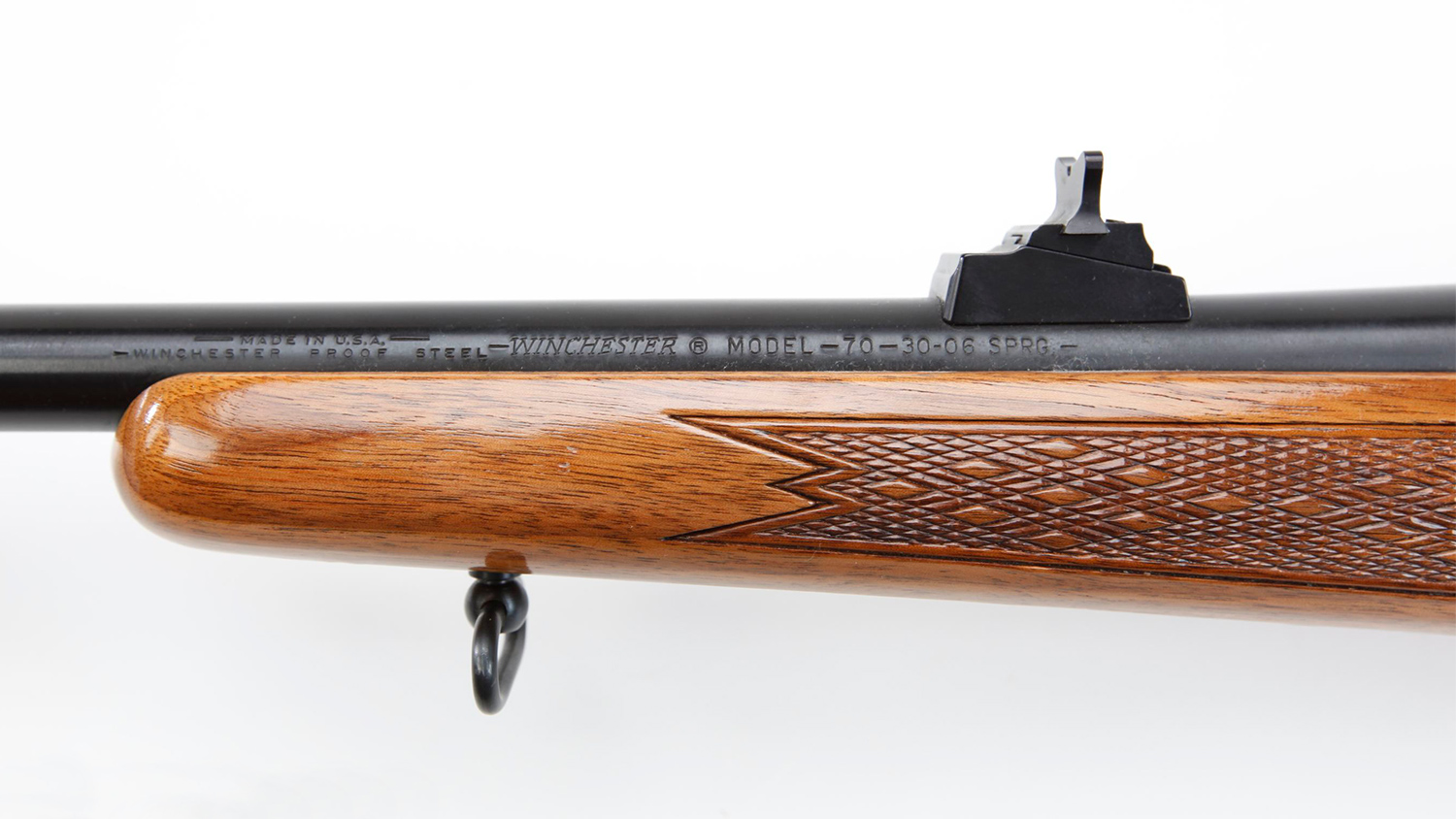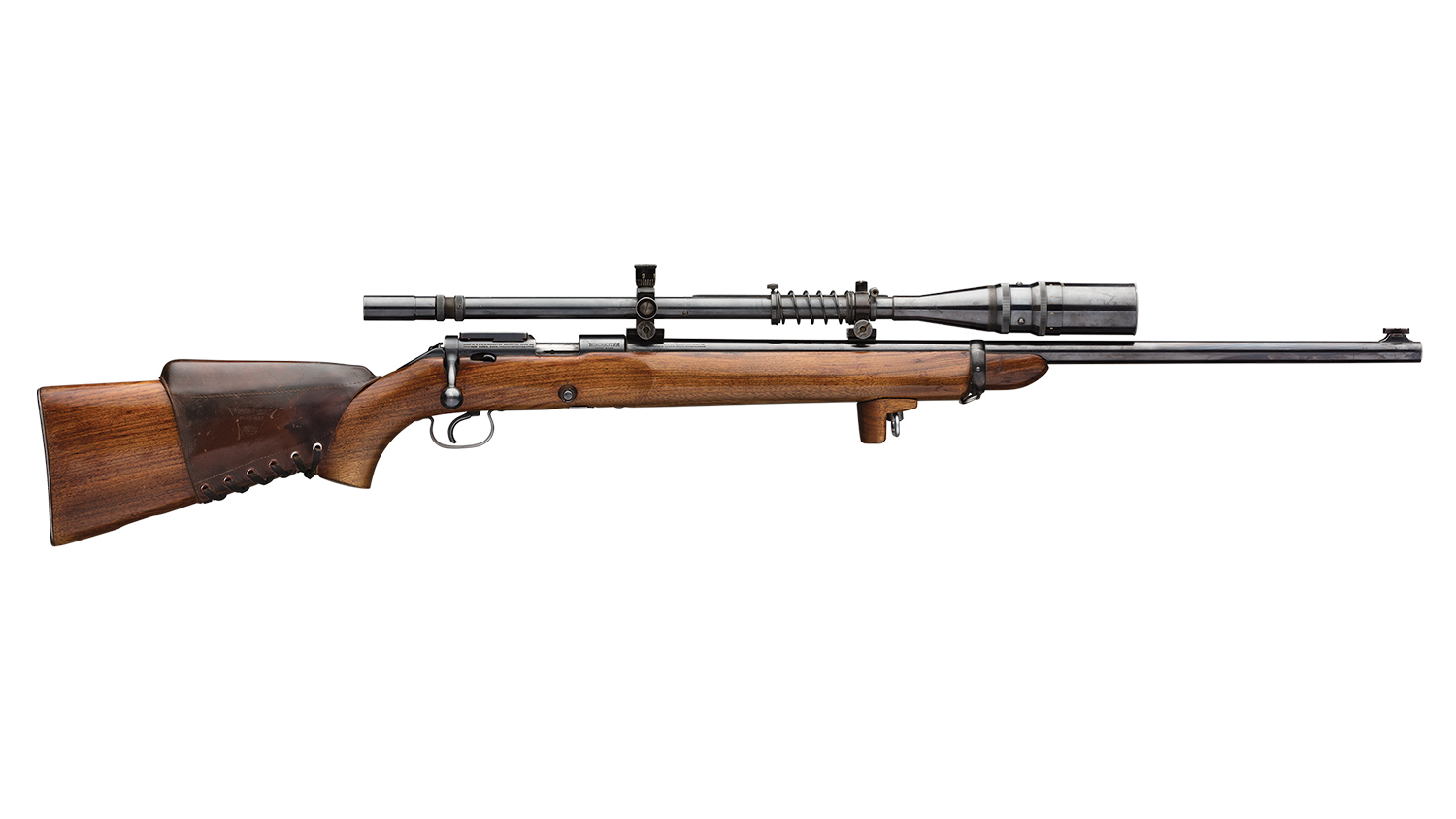

On October 7, 1879, John Moses Browning of Ogden, UT, received U.S. Patent number 220,271 (his first of 128) for a “Breech Loading Firearm.” Four years later Winchester purchased the patent and manufacturing rights and in 1885 began selling the Winchester Single Shot, known popularly as the “high wall.” Over the span of its manufacture (1885-1920) the Single Shot was chambered for just about every cartridge known, from the .22 short to .50 caliber boomers, and was put to every use a rifle can be—from a training rifle to big game rifle to competition rifle.
The Winchester Single Shot, a lever operated falling block action, owed its high wall nickname to the action’s sidewalls which extended far up the action to support the top of the breech block which was a strong action. Famous barrel maker Harry Pope considered the high wall to be the best single shot action ever made and favored it for the installation of his legendary barrels. There was also a “low wall” model whose action side walls did not extend so high making it easier to load the lower power, smaller cartridges.
Schuetzen riflemen in their classic period (1890-1915) were the finest offhand riflemen in the world. On July 4, 1895, Shooting and Fishing reported on a huge Schuetzenfest held in New York City, with 30,000 attendees and 600-plus entries. While nearly half the shooters used Ballard rifles, the next most popular rifle was the Winchester.
The high wall was made in a vast number of variants, calibers and models: four trigger options (one conventional; three kinds of set triggers) along with five barrel weight choices. Among the variants were the Schuetzen model (1890s) and the Winder musket (1905). The Winder was informally named for COL C.B. Winder a prominent rifleman and a strong advocate of marksmanship. The musket had a full length stock and was used by the military services, civilian clubs and schools for training and competition.
The Single Shot is still around today; many originals survive and faithful reproductions are available. They remain popular with long-range black powder shooters.
While the Winchester Single Shot was a popular and excellent rifle it arrived at a unique time in American shooting. In 1892, seven years after the Single Shot’s appearance, the U.S. Army adopted the Krag-Jorgenson bolt action repeating rifle. The U.S. love affair with the bolt action rifle had begun, fueled initially by the military’s need but sustained by the versatility, strength and firepower of the repeater.
The Winchester Model 70

The Winchester Model 70 was introduced in 1936. An earlier rifle, the Model 54, had served as a working prototype and provided useful guidance on what made a good bolt action rifle. The Model 54 was by no means a flop—Francis Conway used a Model 54-actioned rifle to win the Member’s Trophy in the 1954 National Matches.
The Model 70 won quick acceptance; its fine trigger was reliable, reproducible in performance, easy to adjust and the lock time was fast. Winchester barrels gave the precision needed for serious competition. The sporting rifle was made in a vast array of calibers and stock styles but the factory-made match rifles, introduced in 1937, came in three variants, all with the Marksman stock: The National Match Rifle (a standard weight barrel, 9 ½ lbs.), the Target model (heavy barrel, 10 ½ lbs.) and the Bull Gun (extra heavy barrel, 13 ¼ lbs.). Until 1957, NRA rules limited the High Power Match Rifle to a maximum weight of 10 ½ lbs. Scope bases and Lyman front and rear sights were standard issue early on. Eventually, other sight combinations were available.
In sporting, target or custom-made configurations the Model 70 quickly became “The Rifleman’s Rifle.”
A list of successful high power competitors and National Champions who used the Model 70 is long, and includes these shooting notables:
- Walter Walsh, 1952 High Power Champion used a Model 70 to win with a 436-43V.
- Arthur Jackson used a Model 70 in the 1948 Olympics and in the 1949 and 1954 World Championship matches, and won the Winchester trophy (300 meters 3 x 40) at Camp Perry in 1955 with a M70.
- Larry Moore won the Wimbledon Cup in 1963 with a M70 (in .30-’06).
- Kenneth Erickson won the Match Rifle Championship in 1960 with a M70.
- David Tubb won several of his High Power Championships with a M70.
- Ben Comfort used Winchester barrels in his precedent setting 1935 win of the Wimbledon Trophy. It is possible the barrels were a product of the M70 development process.
In 1964 Winchester introduced a new version on the Model 70—one consistent with the needs and capabilities of modern manufacturing. Four years later an improved version was released with a new feature—an anti-bind device in the bolt that guaranteed smooth bolt operation.
One of the versions of these rifles was used in the 1970 World Shooting Championships. In 1970 the ISSF World Shooting Championships were held at the Ben Avery Range near Phoenix, AZ. One of the events was the 300 meter Standard Rifle match. For this competition Winchester supplied the International Army Rifle: iron sights, no palm rest or hook butt plate in a deep belly stock with a blind magazine. To be sure of making the weight limit the rifles had spruce stocks, light but strong. The AMU’s Jack Foster used his International Army Rifle to win the World Championship in the event.
I can attest that the International Army Rifle also makes a fine across-the-course rifle for NRA High Power Rifle competition.
The Winchester Model 52
The Winchester Model 52 was introduced during the smallbore phase of the 1919 National Matches held at the Navy Range at Caldwell, NJ—the first NRA National Smallbore Rifle Championship. Winchester wanted to produce a bolt action .22 caliber rifle that accurately simulated the Model 1903 Springfield rifle. A smallbore replica would allow cheap training at closer ranges or indoors and provide a way to quickly teach marksmanship to novices.
The new rifle had the same weight and length of pull as the Springfield and the stock was patterned after the ’03 stock. Winchester 52 variants through the C model came with a 5-or 10-shot magazine, curved to accommodate the rim of the .22 rimfire cartridge allowing glitch-free feeding. The rear sight was of “ladder” construction much like the sight on the 52’s inspiration.
The rifles brought to Caldwell were not production models: they were all hand-assembled and intended primarily to get the word out—and to judge shooter reaction, which was very enthusiastic.
Of the 20 members of the Dewar Team, (the first modern Dewar match—prone shooting at 50 and 100 yards) Twelve had cadged the new Winchesters (the other eight shooters used a mixture of rifles: Savage, Stevens, Ballards and a Winchester musket—the new rifle’s competition). Commercial sales of the new rifle began the following year.
The 52 evolved. The stocks became less “military,” lock time was reduced with a “speed lock” and the sights got better. Subsequent variations were distinguished by letter suffixes: the A model in the early 1930s and, in 1937, the B model introduced an improved, adjustable trigger and a target stock in the “Marksman” pattern having a wide forend and a higher comb to give better face support with iron or telescopic sights.
In its lifetime, the 52 was produced in four variants: the standard barrel (9 3/4 lbs.), the heavy barrel (11 lbs.) and the bull gun (12 lbs.). The fourth variant, the sporting rifle, was a high ticket item selling for substantially more than the target versions.
The high point in the 52’s evolution was the introduction of the C model in 1951. NRA smallbore rules then mandated a three-pound trigger. Shooters believed that the ideal trigger had no movement after sear release (“overtravel”) so that the release of the three-pound trigger would not transmit disturbance to the rifle. Winchester’s engineers established that people could not detect a trigger movement of 0.005 inches. The 52C’s “Micro-Motion” trigger, by a system of levers, translated the 0.005 inches travel to a safe sear engagement and had no perceptible motion on release. The 52C also featured an improved stock design and improved heat treatment of the bolt and action. Subsequently, the 52D (1961) included these features in a single shot action—the 52C’s action with a solid bottom.
The Model 52 International Match Rifle appeared in 1969 in response to the increasing interest in international-style equipment—it had a hook butt plate, palm rest and a laminated thumbhole stock. In 1975 the International Prone Rifle was introduced—a rifle whose conventional style stock had a high comb that ran much farther forward than customary. All of the international rifles had the option of a Kenyon trigger capable of very light adjustment. Winchester’s efforts were for naught; the Model 52 ceased production in 1979.
For six decades the Winchester 52 had dominated U.S. smallbore rifle competition. No other smallbore match rifle enjoyed the success of the 52. There are still a lot of them out there and they are still winning matches though usually restocked, rebarreled and otherwise modified to suit the owner. Keep an eye out for them at your next match.
The author would like to thank George Harris, Bruce Meredith and Jack Foster for enjoyable conversations that supplied valuable information for this article.
Learn more about Winchester’s 150th Anniversary at this link: www.winchesterguns.com/news/articles/150-years-of-winchester.html.

































